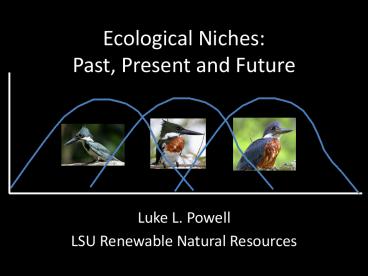Ecological Niches: Past, Present and Future - PowerPoint PPT Presentation
1 / 38
Title:
Ecological Niches: Past, Present and Future
Description:
Ecological Niches: Past, Present and Future. Luke L. Powell. LSU Renewable Natural Resources ... No two species with identical competitive effects on one ... – PowerPoint PPT presentation
Number of Views:329
Avg rating:3.0/5.0
Title: Ecological Niches: Past, Present and Future
1
Ecological Niches Past, Present and Future
- Luke L. Powell
- LSU Renewable Natural Resources
2
Grinnell (1917)
- The place in an environment that a species
occupies
California thrasher, Toxostoma redivivum Photo
from Wikipedia
3
Gause (1936)
- Competitive exclusion principle
- No two species with identical competitive
effects on one another can exist locally
Photo www.nceas.ucsb.edu/alroy/lefa/Gause.jpg
4
G. Evelyn Hutchinson (1957)
An n-dimensional hypervolume???
- Lets consider the concept of niche
- If I knew what it meant Id be rich.
- Its dimensions are n
- But a knowledge of Zen
- Is required to fathom the bitch.
- -Cottam and Parkhust
Photo from Yale Peabody Archives Figure from
wiki.verkata.com
5
A single-axis (i.e. single-dimension)
fundamental niche
Range of temperature tolerance
just right
Too hot
Too cold
Temperature
6
Another single-axis fundamental niche
Range of salinity tolerance
just right
Too salty
Too fresh
Salinity
7
A two-axis fundamental niche
Too salty
ok
Too cold
Too hot
Salinity
Too fresh
Temperature
8
A two-axis realized niche
Niche of a superior competitor
Too salty
ok
Too cold
Salinity
Too hot
Area of fundamental niche lost due to competition
Too fresh
Realized niche after competition
Temperature
Too much overlap Competitive exclusion!
9
A three-axis realized niche for trees
- X Mesophytism
- Y Soil drainage conditions
- Z Disturbance
Fig Whittaker 1973 Am. Nat. v. 107(955)
10
G. Evelyn Hutchinson (1957)
An n-dimensional hypervolume???
Photo from Yale Peabody Archives Figure from
wiki.verkata.com
11
Robert MacArthur (1958)
Photo Wikipedia Painting Debbie Kaspari
12
Robert MacArthur (1958)
- Actually, to permit coexistence, it seems
necessary that each species, when very abundant,
should inhibit its own further increase more than
it inhibits the others.
K1 / a
Intraspecific competition (i.e. organisms effect
on envt.)
N2
K2
K1
K2 / ß
N1
Photo Wikipedia Graph Modified from Kyles
stable equilibrium
13
Community Ecology of Neotropical Kingfishers
Species Packing Mechanisms
- James Van Remsen Jr.
- University of California Publications in Zoology
v. 124. 1991.
14
- Objective Determine the proximate mechanism that
explains the change in species number between the
five- and three-species communities
15
- Map from www.geographigguide.net
16
(No Transcript)
17
- Megaceryle torquata, Ringed Kingfisher
Chloroceryle amazona, Amazon Kingfisher
Photo Diego Sanches, Wikipedia
Photo LIP Kee Yap, Wikipedia
18
Chloroceryle americana, Green Kingfisher
Chloroceryle inda, Green-and-Rufous Kingfisher
Photo Hans Hillewaert, Wikipedia
Photo Alberto Garcia Rios, Internet Bird
Collection
- Chloroceryle aenea,
- American Pygmy Kingfisher
Photo Uncredited, Wikipedia
19
Niche-breadth Mechanism
- Prediction narrower niche-breadths in more
diverse communities
20
Niche-breadth Mechanism
- Conclusion No evidence for hypothesis
Where niche breadth 1/? (Pij)2 P is proportion
of diet measured over j prey length categories
? NARROWER?
? BROADER?
? BROADER?
21
Niche-overlap Mechanism
- Prediction niche overlaps will be greater in
more diverse communities
22
Niche-overlap Mechanism
- Niche Dimentions
- Prey Length
- Distance of dive entry point from shore
- Habitat
- Open/shaded
- Photo by Claude
- Schneider
- http//www.claudeschneiderphotography.com
23
(3-axis) Niche-overlap Mechanism
- Result Niche overlap significantly greater in
larger community (P lt 0.05)
More overlap
Less overlap
24
Resource-base Mechanism
- Prediction directional reduction in resource
base excludes species
25
Resource-base Mechanism
26
(No Transcript)
27
Resource-base Mechanism
28
Criticism of Remsen (1991)
- Niche axes not consistent among hypothesis tests
- No way to quantify relative importance of
mechanisms - Prey size confounded by habitat
- Results dependent on method of calculation of
niche overlap
29
Chase and Leibold (2003)
- Niche
- The environmental conditions that allow a
species to satisfy its minimum requirements so
that the birth rate of a local population is
equal or greater than its death rate along with
the set of per capita impacts of that species on
these environmental conditions.
Requirement component
Niche
Impact component
30
Chase and Leibold (2003)
Slope of Impact component for Sp 1
ZNGI Sp 1
Slope of Impact component for Sp 2
Sp 2 ALONE
COEXIST
Resource A
Sp 1 ALONE
ZNGI Sp 2
Can replace Resource With predator Or stress
Stresses a two-dimensional approach
Resource B
Impact Components
Graph Modified from Kyles
31
Criticism of Remsen (1991)
- Niche axes not consistent among hypothesis tests
- No way to quantify relative importance of
mechanisms - Prey size confounded by habitat
- Results dependent on method of calculation of
niche overlap - Impact component not considered
32
Future Application of Niche Research
- Species distribution along gradients
- Temperature
- Precipitation
- Stressors associated with fragmentation
33
(No Transcript)
34
Context
35
Acknowledgements
- Phil Stouffer for template of slides on
fundamental vs. realized niche - Kyle Harms for use of graphs and help with
literature and organization
36
THANKS
- Drawings by Jan Dungel
- www.jandungel.com
37
Chase and Leibold Sorting on Gradients
- The axis of factors along which species interact,
be they resources, predators, or stresses, can be
used to envision a gradient in these factors when
we expand our view to a regional spatial scale.
38
Elton (1927)

